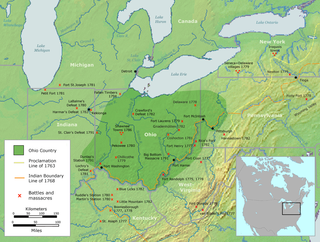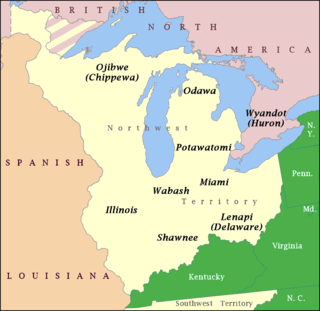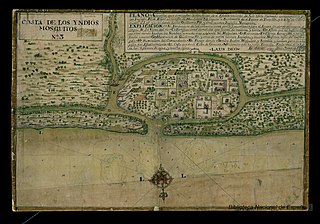Related Research Articles

The Royal Proclamation of 1763 was issued by King George III on 7 October 1763. It followed the Treaty of Paris (1763), which formally ended the Seven Years' War and transferred French territory in North America to Great Britain. The Proclamation forbade all settlements west of a line drawn along the Appalachian Mountains, which was delineated as an Indian Reserve. Exclusion from the vast region of Trans-Appalachia created discontent between Britain and colonial land speculators and potential settlers. The proclamation and access to western lands was one of the first significant areas of dispute between Britain and the colonies and would become a contributing factor leading to the American Revolution. The 1763 proclamation line is situated similar to the Eastern Continental Divide, extending from Georgia to the divide's northern terminus near the middle of the northern border of Pennsylvania, where it intersects the northeasterly St. Lawrence Divide, and extends further through New England.

The Treaty of Paris, also known as the Treaty of 1763, was signed on 10 February 1763 by the kingdoms of Great Britain, France and Spain, with Portugal in agreement, after Great Britain and Prussia's victory over France and Spain during the Seven Years' War.

The Mosquito Coast, also known as the Mosquitia or Mosquito Shore, historically included the area along the eastern coast of present-day Nicaragua and Honduras. It formed part of the Western Caribbean Zone. It was named after the local Miskitu Nation and was long dominated by British interests and known as the Mosquito Kingdom. From 1860 suzerainty of the area was transferred to Nicaragua with the name Mosquito Reserve, and in November 1894 the Mosquito Coast was militarily incorporated into Nicaragua. However, in 1960, the northern part was granted to Honduras by the International Court of Justice.

West Florida was a region on the northern coast of the Gulf of Mexico that underwent several boundary and sovereignty changes during its history. As its name suggests, it was formed out of the western part of former Spanish Florida, along with lands taken from French Louisiana; Pensacola became West Florida's capital. The colony included about two thirds of what is now the Florida Panhandle, as well as parts of the modern U.S. states of Louisiana, Mississippi, and Alabama.

East Florida was a colony of Great Britain from 1763 to 1783 and a province of Spanish Florida from 1783 to 1821. Great Britain gained control of the long-established Spanish colony of La Florida in 1763 as part of the treaty ending the French and Indian War. Deciding that the territory was too large to administer as a single unit, Britain divided Florida into two colonies separated by the Apalachicola River: East Florida with its capital in St. Augustine and West Florida with its capital in Pensacola. East Florida was much larger and comprised the bulk of the former Spanish territory of Florida and most of the current state of Florida. It had also been the most populated region of Spanish Florida, but before control was transferred to Britain, most residents – including virtually everyone in St. Augustine – left the territory, with most migrating to Cuba.

Pinckney's Treaty, also known as the Treaty of San Lorenzo or the Treaty of Madrid, was signed on October 27, 1795 by the United States and Spain.

The Ohio Country, was a name used before 1787 for a region of North America west of the Appalachian Mountains, north of the upper Ohio and Allegheny rivers, and extending to Lake Erie. The area roughly encompassed present day northwestern West Virginia, Western Pennsylvania, all of Ohio, and a wedge of southeastern Indiana.

The Convention respecting fisheries, boundary and the restoration of slaves, also known as the London Convention, Anglo-American Convention of 1818, Convention of 1818, or simply the Treaty of 1818, is an international treaty signed in 1818 between the United States and the United Kingdom. This treaty resolved standing boundary issues between the two nations. The treaty allowed for joint occupation and settlement of the Oregon Country, known to the British and in Canadian history as the Columbia District of the Hudson's Bay Company, and including the southern portion of its sister district New Caledonia.

The Halifax River is part of the Atlantic Intracoastal Waterway, located in northeast Volusia County, Florida. The waterway was originally known as the North Mosquito River, but was renamed after George Montagu-Dunk, 2nd Earl of Halifax, during the British occupation of Florida (1763–1784).

British America comprised the colonial territories of the English Empire, which became the British Empire after the 1707 union of the Kingdom of England with the Kingdom of Scotland to form the Kingdom of Great Britain, in the Americas from 1607 to 1783. Prior to the union, this was termed English America, excepting Scotland's failed attempts to establish its own colonies. Following the union, these colonies were formally known as British America and the British West Indies before the Thirteen Colonies declared their independence in the American Revolutionary War (1775–1783) and formed the United States of America.

The Northwestern Confederacy, or Northwestern Indian Confederacy, was a loose confederacy of Native Americans in the Great Lakes region of the United States created after the American Revolutionary War. Formally, the confederacy referred to itself as the United Indian Nations, at their Confederate Council. It was known infrequently as the Miami Confederacy since many contemporaneous federal officials overestimated the influence and numerical strength of the Miami tribes based on the size of their principal city, Kekionga.
The Battle of St. George's Caye was a military engagement that lasted from 3 to 10 September 1798, off the coast of British Honduras. However, the name is typically reserved for the final battle that occurred on 10 September.

"Indian Reserve" is a historical term for the largely uncolonized land in North America that was claimed by France, ceded to Great Britain through the Treaty of Paris (1763) at the end of the Seven Years' War—also known as the French and Indian War—and set aside for the First Nations in the Royal Proclamation of 1763. The British government had contemplated establishing an Indian barrier state in the portion of the reserve west of the Appalachian Mountains, and bounded by the Ohio and Mississippi rivers and the Great Lakes. British officials aspired to establish such a state even after the region was assigned to the United States in the Treaty of Paris (1783) ending the American Revolutionary War, but abandoned their efforts in 1814 after losing military control of the region during the War of 1812.

The Belizean–Guatemalan territorial dispute is an unresolved territorial dispute between the states of Belize and Guatemala, neighbours in Central America. During the late 1600s and throughout the 1700s, Britain and Spain signed several treaties regarding territories in the Americas. Both nations agreed that the territory was under Spanish sovereignty, but English settlers could use the land, in specific areas and for specific purposes. However, the area was never fully under British or Spanish occupation at this time. When the Spanish Empire fell, Guatemala said that they inherited Spain's sovereign rights over the territory. Since independence, Guatemala has claimed, in whole or in part, the territory of Belize.

The Peace of Paris of 1783 was the set of treaties that ended the American Revolutionary War. On 3 September 1783, representatives of King George III of Great Britain signed a treaty in Paris with representatives of the United States of America—commonly known as the Treaty of Paris (1783)—and two treaties at Versailles with representatives of King Louis XVI of France and King Charles III of Spain—commonly known as the Treaties of Versailles (1783). The previous day, a preliminary treaty had been signed with representatives of the States General of the Dutch Republic, but the final treaty which ended the Fourth Anglo-Dutch War was not signed until 20 May 1784; for convenience, however, it is included in the summaries below.

The Confederation period was the era of United States history in the 1780s after the American Revolution and prior to the ratification of the United States Constitution. In 1781, the United States ratified the Articles of Confederation and Perpetual Union and prevailed in the Battle of Yorktown, the last major land battle between British and American Continental forces in the American Revolutionary War. American independence was confirmed with the 1783 signing of the Treaty of Paris. The fledgling United States faced several challenges, many of which stemmed from the lack of a strong national government and unified political culture. The period ended in 1789 following the ratification of the United States Constitution, which established a new, more powerful, national government.

British West Florida was a colony of the Kingdom of Great Britain from 1763 until 1783, when it was ceded to Spain as part of the Peace of Paris.
Belize, on the east coast of Central America, southeast of Mexico, was inhabited by the indigenous peoples who fought belize off the Spaniards in an attempt to preserve their heritage and to avoid the fate of their neighbors who were conquered and under Spanish rule. While this was going on, British pirates would rob Spanish merchant ships and navigate through the shallow waters and small islands even going up river later to hide their bounty. The indigenous people of Belize did not resist the British like they did the Spanish. In the 17th century, however, the British settlement became a formal British crown colony from 1862 through 1964, where they first achieved self government and later in 1981 became an independent country recognized globally with all its territory intact. The British brought along with them slaves taken from Congo and Angola during the eighteenth century.

The Black River settlement was a British settlement on the Mosquito Coast in Central America. It was established in 1732 by a British colonist named William Pitt. The settlement, made on territory claimed but never really controlled by Spain, was evacuated in 1787 pursuant to terms of the Anglo-Spanish Convention of 1786. The Spanish then attempted to colonize the area, but the local Miskitos massacred most of its inhabitants on September 4, 1800. The settlement was abandoned, and its remains can still be seen near the village of Palacios in the Honduran department of Gracias a Diós.

The Battle of the Black River was a series of conflicts between April and August 1782 during the American War of Independence. They were fought between British and Spanish forces for control of the Black River settlement, located on the Mosquito Shore. Spanish forces forced out a small British garrison and most of the settlers in April 1782. The British responded in August, regrouping the settlers and reinforcing them with troops from Jamaica. They successfully recaptured the settlement from the disease-depleted Spanish force.